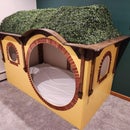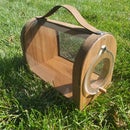Introduction: Minecraft Sword Letter Opener
I have been wanting to make a letter opener for my desk and I finally decided on the minecraft sword. I did some looking around and no one had made one before so I thought this would be a unique thing to display. Because this was being made out of steel I decided to design this off of the iron sword from the game. This ended up being a bit more of a pain then I originally though it would be mostly due to the shape of the blade but I'm happy with how it turned out.
Step 1: Creating the Pattern
When making this letter opener I wanted to make sure that it was the size I wanted. Because Minecraft is pixelated this was easy to do because all you need is a grid and you can sketch the design on that. For my grid I used Microsoft Word and added grid lines and then used the Snipping Tool to capture the grid and print it. If it not the size you want then you can scale the print until it is the size you want. I did not have to scale mine. The Minecraft Sword design is 16 x 16 pixels, your grid will need to be at least this large to make a complete design. My grid came out to be about 4 inches by 4 inches if you want yours the same size as this one.
Step 2: Cutting the Steel to Shape
Now that I have the design, I can start cutting it out on some steel. I used some 1/8 in thick mild steel that I had laying around for this. I think this thickness was pretty good, It made for a hefty letter opener, and I used mild steel because you don't need hardened steel for a letter opener. I considered using some 1/8 in thick O1 tool steel that I have for making knives so I could harden it but it would probable be a waste because the pixelated design of this sword does not make for an effective knife.
For cutting this out I used a angle grinder, I finally got one and it was so much easier that using a hacksaw, but a hacksaw will definitely work if that's all that you have. Once I had the rough shape cut out then I used a combination of my belt grinder and files to refine the shape and clean it up. Don't sand it down quite to the line as it is always easier to remove material when cleaning it up later than it is to add it.
Step 3: Making the Cross Guard and Pommel
Now that the main shape of the sword was created it was time to make the Cross Guard and Pommel. I used some of the remaining 1/8 in mild steel for both of these parts. You will need two of each as one will need to go on either side of the blade.
Step 4: Attach the Cross Guard and Pommel
I decided to add some hidden pins to the handle components so that I could align the parts consistently and so that they would be retained better. To do this I drilled the holes on the blade part first and then put the Cross Guard or Pommel under it and by controlling the drill depth I only drill part of the way through the pieces. I then used some 1/8 in brass rod that I cut and sanded to length to serve as the hidden pins.
Note: You may want to drill two holes in the pommel so that it is easier to keep orientated when gluing together.
Step 5: Clean Up Cross Guard and Pommel
It was then time to clean up the edges so that they were all even across all three parts. To do this I used some double sided tape and the pins to hold the layers in the correct position and then filed the edges to that they were all even. To clean up the inside edges I cut some smaller pins and left out the blade portion and filed even the inside edges. This is why I didn't file quite to the line earlier, I wanted to make sure all the pieces had enough material to remove to make them even.
Step 6: Making the Handle
Time to make the handle. The sword handle has a mix of different colored browns which I wanted to replicate to the best of my ability. It has a total of four different browns so I needed four different woods with varying color. I was able to find a way to get four different colors with just three pieces of scrap wood that I had from other projects. This gave me the variety that I was looking for.
I made the two sides of the handle differently. One, I glued the pieces together and then sanded them to shape before final gluing and then shaping. The other method I used was shaping the pieces into the correct size cubes before gluing them together. Both of these methods worked but the first one was definitely the easiest. Just take your time and it shouldn't be too bad.
Step 7: Attaching and Clean Up the Handle
With the Cross Guard and Pummel filed to shape and the handle glued together it is now time to drill the holes for the hidden pins in the handle. This was done the same as with the Cross Guard and Pummel except you may not be able to use the depth control on the drill press if your handle is not evenly flat. You might just have to eyeball it like I had to. Just don't drill too deep. You don't want to have to make those handles again. Once the holes are drilled I made the pins and taped the handles down and filed the edges of the handle so that they were even like I did on the other parts. Then you sand it down when assembled so that it is the same height as the Pommel and Cross Guard.
Step 8: Profile the Blade
Now to add the edge to the blade. To start this I used a trick many people use when making knives to make sure the bevel is even on edge. To do this you mark the edge of the steel with a sharpie and then use a drill bit that is the same diameter as you part is thick and then you run it along the edge. The tip of the drill removes the sharpie along the center of the material. this gives you a line down the center of the edge. You will sand/file down to that line on either side of the blade. I did this by clamping it down onto a piece of thick steel and then used hand files to give the edge the shape I was looking for.
Step 9: Lots and Lots of Sanding
Now that the shape of the blade is complete it is now time to make it shiny. I started out with fine emery paper and progressed to 400, then 1000, then 2000, and finally 3000 git sandpaper. I then followed this up with a buffing wheel attached to a drill. This really brought it to the finish I was looking for. After it was all shiny I used a knife to score the pixel grid onto the blade for everywhere it will be exposed. Along with sanding the blade, I also sanded the middle top of the Cross Guard down as well as you will not be able to sand this area once it has been assembled and glued.
Note: This step was a pain in the butt and took forever to do. I probably spent around 12 hours sanding all the little teeth of the blade and it still isn't quite as perfect as I could like. I just had enough and called it good enough. If you don't care that much you should probably just sand to 400 grit or so and leave it a matte finish.
Step 10: Glue It Up
Time to glue it all together. I used a long set two part epoxy to glue the Cross Guards and Pummels into place. You will not want to glue the wood handle on yet if you plan on darkening the handle. When you clamp it together you will want to remove as much epoxy as possible from anywhere it leaked onto the main blade. It would be very difficult to remove from those internal corners after it hardens.
Note: In hindsight it would have been nice to add two pins to the pommel so that you don't have to try and keep both sides oriented correctly when trying to clamp it together.
Step 11: Sand the Handle
The handle is glued but it still needs to be sanded to match the blade. Before I started I added blue painters tape to the blade to prevent any scratches when working on the handle. I sanded down the edges and tops of the handle components the same as I did for the blade. And as I did with the blade I then marked the pixel grid on these components.
Step 12: Darken the Handle
The Minecraft Sword has darker handle components then the blade. I wanted to replicate this so I used liquid cold blue on the metal components to darken them to look more like the game version. It doesn't show well in these pictures due to my lighting but it is significantly darker. The pictures at the beginning and end show the color difference better.
Step 13: Add the Wood Handle
Now that the rest of the handle is complete it is time to glue the wood handle on. This was done using the same epoxy as the other handle components. When the glue has set then you just add whatever finish you want. For mine I used Danish oil because that is what I already had.
Step 14: Complete! Final Thoughts.
It is now complete. It took forever and I now know why no one has made one of these before. If you have a lot of time on your hands and want one of these then by all means go for it. Or change the design to look like something else and save yourself the hassle of sanding all those stinking edges of the blade.

First Prize in the
Minecraft Challenge 2018

Participated in the
Epilog Challenge 9













